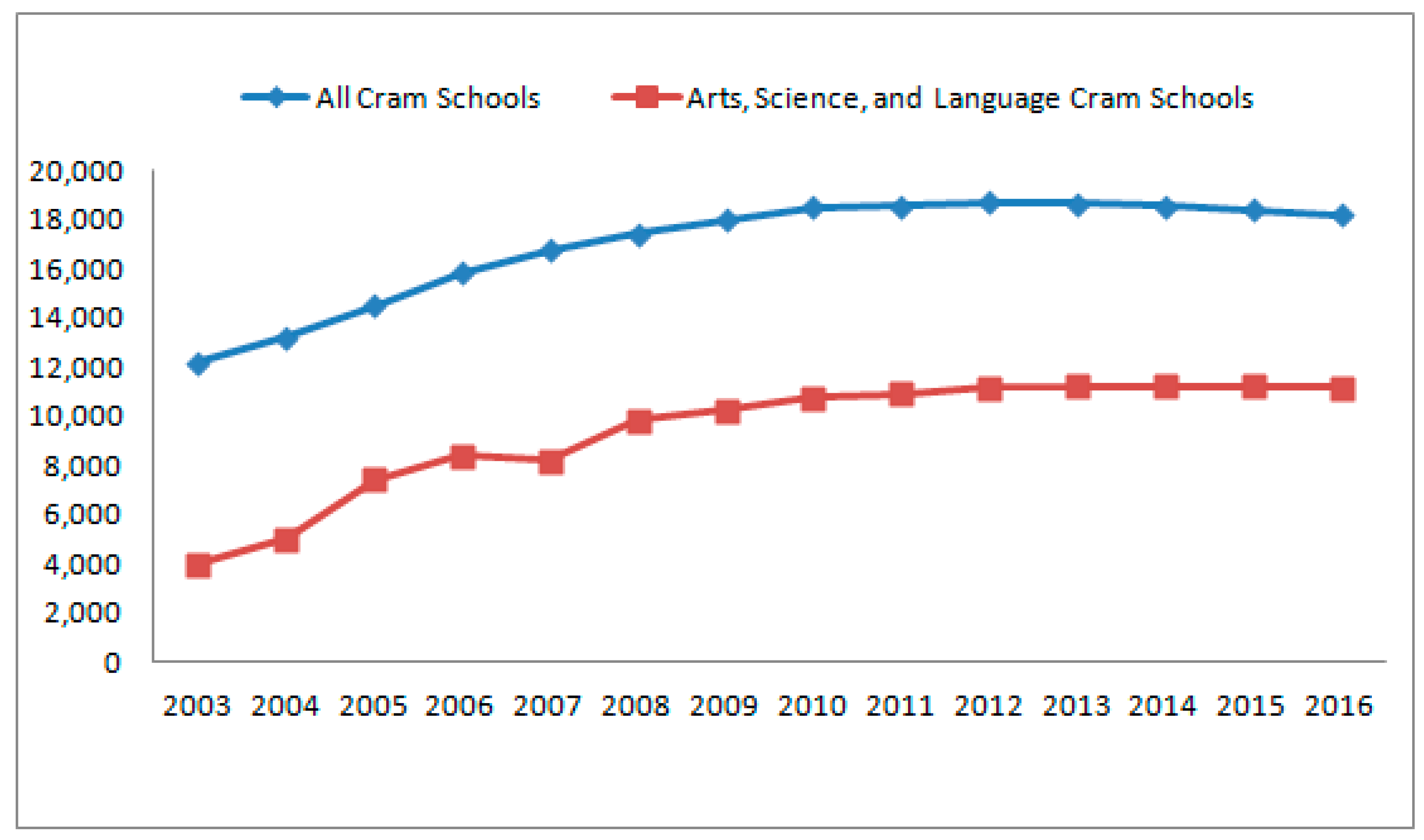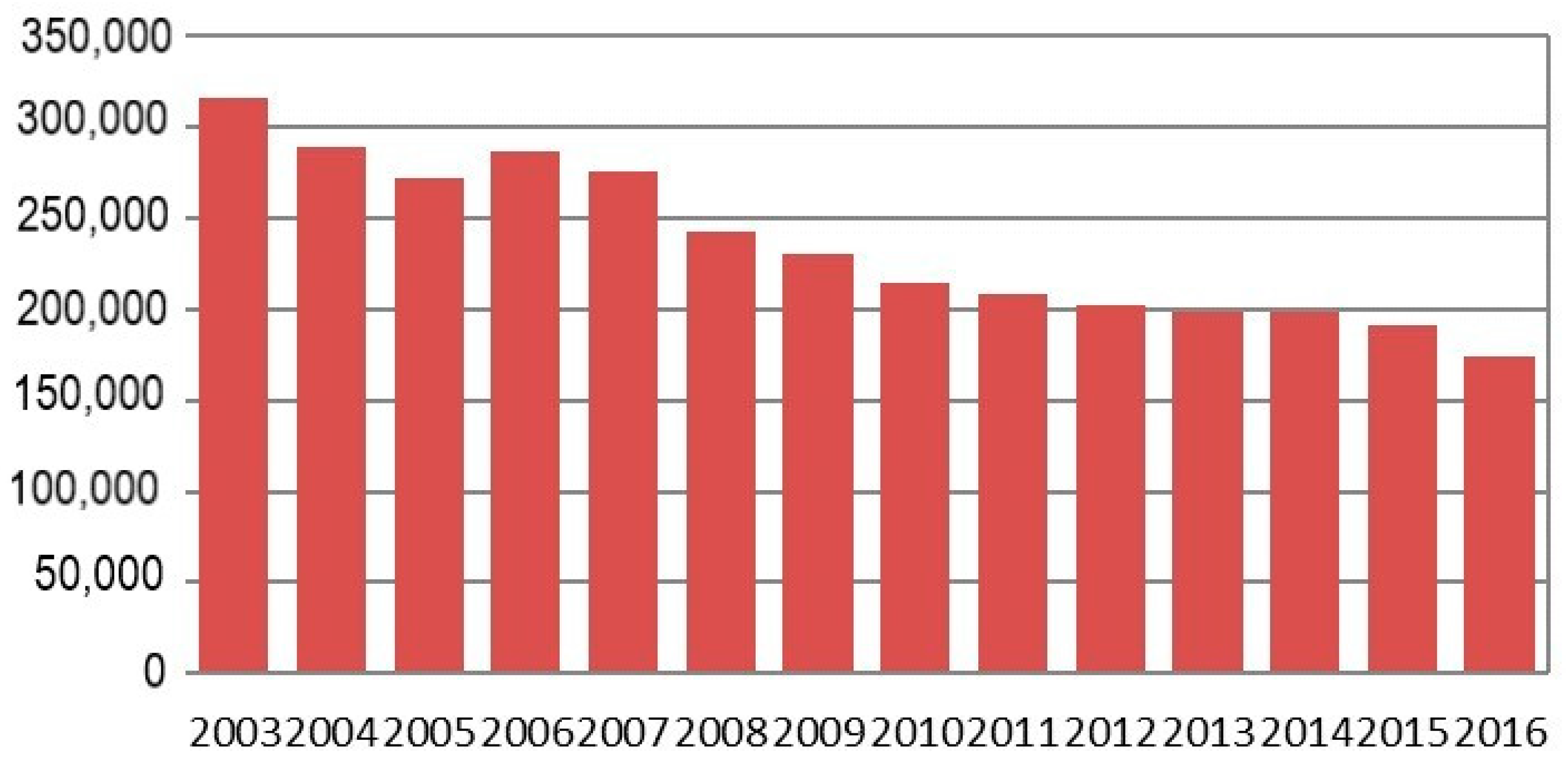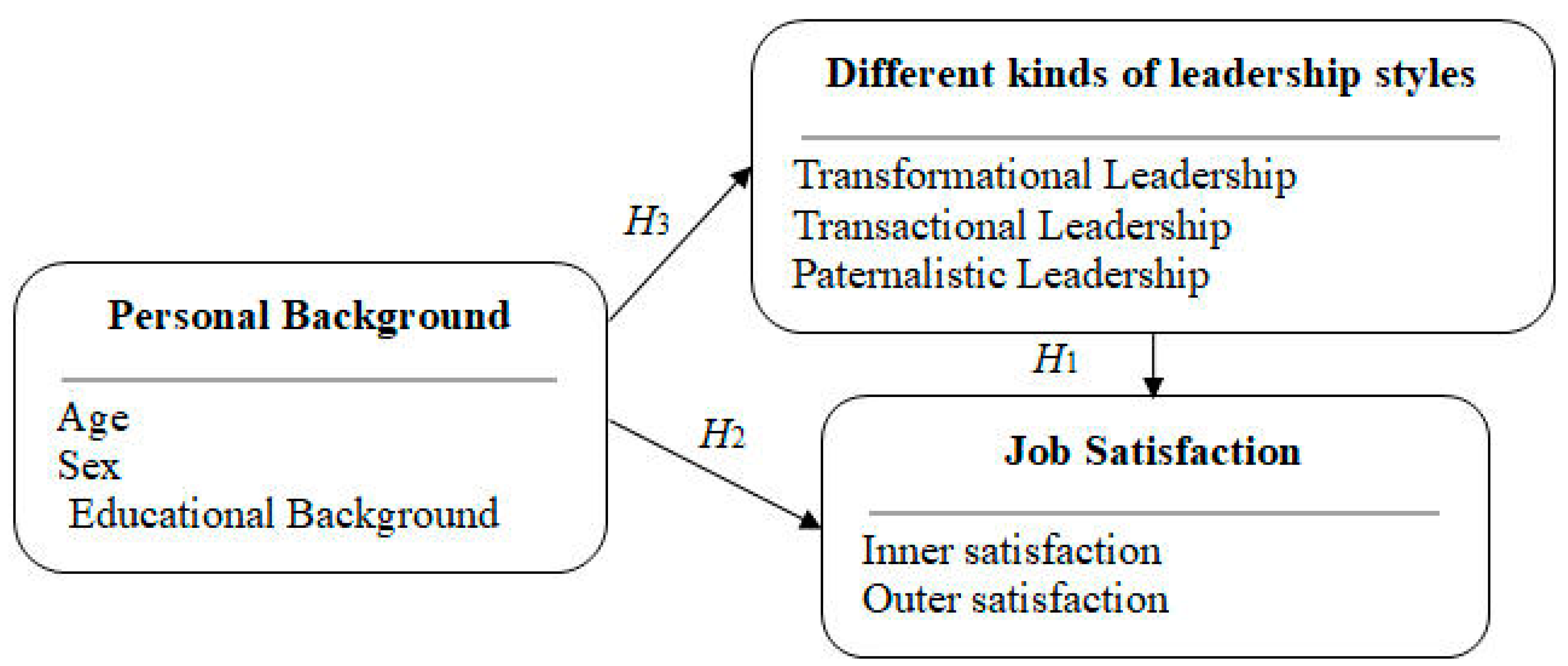Influences of Transformational Leadership, Transactional Leadership, and Patriarchal Leadership on Job Satisfaction of Cram School Faculty Members
Abstract
:1. Introduction
1.1. Transformational Leadership
- Idealized influence means a leader will be respected and trusted because of his/her self-confidence, attitude of ideology or dramatic and emotional acting. The leader should have a vision and passion that can make his/her subordinates follow his/her orders sincerely.
- Inspirational motivation means a leader can use his/her charm to convey the goal of an organization, resulting in subordinates’ optimism and hope regarding the development and future of the company; working motivation and coherence are the final purposes.
- Intellectual stimulation means a leader should encourage his/her subordinates to enhance their knowledge, creativity, and ponder deeply about problems.
- Individualized consideration means a leader respects and cared for his/her subordinates. Subordinates will feel like an important part of the team and subsequently will work harder.
1.2. Transactional Leadership
1.3. Patriarchal Leadership
- Teaching behavior means the leader teaches subordinates how to achievegoals.
- Moral leadership refers to the leader who is considered a person who possesses strong morals and would sacrifice himself/herself in order to let others achieve a goal.
- Centralization of authority means the management power is controlled by the leader and is not shared with any subordinates.
- A leader keeps a distance from subordinates in order to maintain authority.
- The intention of leading means the leader does not express his/her thoughts to subordinates in order to protect his/her own authority and control.
- A leader controls an organization directly.
1.4. Job Satisfaction
2. Research Design
2.1. Research Assumptions
2.2. Research Limitations
- The field location of this study is in New Taipei City, therefore different results may exist in other cities.
- Since the identity of the researcher is an educator, this may have affected the reporter’s bias in that they tried to meet the researcher’s expectations when providing information.
- Not enough works of literature which focus on Taiwan or cram schools were reviewed in this study.
2.3. Sample of Research
2.4. Instrument and Procedures
3. Results and Discussion
4. Conclusions and Discussion
4.1. Conclusions
4.2. Discussions
- (1)
- We suggest future research uses an experimental design study, which could observe the changes of an organization or employee under different kinds of leadership styles. Samples can be assigned to different companies that are in the same industry and the same size, but the companies have different leadership styles. The samples change to another company that has another leadership style six months later, after calculating their job satisfaction scale. Another test of the job satisfaction scale will be done after another six months.
- (2)
- We suggest cram schools’ leaders apply transactional leadership to their organization. Employees’ outer job satisfaction might be raised as a result. For example, cram schools could attach a strict bonus system for enrolling new students or completing special tasks, such as holding events or competitions. The system should have clear information and must be reviewed and improved regularly. For cram schools that already apply transactional leadership, patriarchal leadership is suggested to stimulate employees’ inner job satisfaction. For example, leaders could act as a father figure to subordinates, acting as a high-moral person who teaches subordinates how to achieve goals.
Author Contributions
Funding
Conflicts of Interest
Appendix A
| Dimensions | Questions |
|---|---|
| Transactional Leadership |
|
| Paternalistic Leadership |
|
| Transformational Leadership |
|
References
- Yukl, G.A. Leadership in Organizations; Prentic-Hall: Upper Saddle River, NJ, USA, 2002. [Google Scholar]
- Ministry of Education. All Cities and Counties: Short-Term Tutorial Information Management System. Number of Busiban in Each City and County. 2017. Available online: http://bsb.edu.tw/ (accessed on 22 September 2018).
- Ministry of Education. All Cities and Counties: Short-Term Tutorial Information Management System. Summary of Elementary Schools (1991 to 2016). 2017. Available online: http://bsb.edu.tw/ (accessed on 21 December 2018).
- Sung, C.T. The study of Relationship between Transformational Leadership and Organizational Learning. Master’s Thesis, 2012. Unpublished Work. Available online: https://ndltd.ncl.edu.tw/ (accessed on 14 January 2019).
- Liu, Y.Y. A Study on the Relationships of Emotional Labor. Emotion Regulation and Engagement: Spiritual Leadership as a Moderator. Master’s Thesis, 2014. Unpublished Work. Available online: https://etds.ncl.edu.tw (accessed on 13 April 2019).
- Daft, R.L. The Leadership Experience, 4th ed.; Thompson South-Western: Mason, OH, USA, 2008. [Google Scholar]
- Downton, J.V.R. Leadership: Commitment and Charisma in the Revolutionary Process; Free Press: New York, NY, USA, 1973. [Google Scholar]
- Bass, B.M. Leadership and Performance Beyond Expectations; Free Press: New York, NY, USA, 1985. [Google Scholar]
- Silin, R.F. Leadership and Values; Harvard Gruyter: Cambridge, MA, USA, 1976. [Google Scholar]
- Sadeghi, A.; Pihie, Z.A.L. Transformational leadership and its predictive effects on leadership effectiveness. Int. J. Bus. Soc. Sci. 2012, 3, 186–197. [Google Scholar]
- Northouse, P.G. Leadership: Theory and Practice, 7th ed.; SAGE Publications, Inc.: Los Angeles, CA, USA, 2015. [Google Scholar]
- Smith, P.C.; Kendall, L.M.; Huh, C.L. The Measurement of Satisfaction in Work and Retirement; Rand McNally: Chicago, IL, USA, 1969. [Google Scholar]
- Gruneberg, M.M. Understanding Job Satisfaction; The Macmillan Press Ltd.: London, UK, 1979. [Google Scholar]
- Spector, P.E. Job Satisfaction: Application, Assessment, Causes, and Consequences; Sage: Thousand Oaks, CA, USA, 1997. [Google Scholar]
- Hulin, C.L.; Judge, T.A. Job attitudes: A theoretical and empirical review. In Handbook of Psychology; Borman, W.C., Ilgen, D.R., Klimoski, R.J., Eds.; John Wiley & Sons Inc.: Hoboken, NJ, USA, 2003; pp. 255–276. [Google Scholar]
- Maurya, V.N.; Kaushik, A.P. On the job training: A stop towards job satisfaction: A case study of public sector organization in Indian scenario. Int. J. Math. Modeling Appl. Comput. 2013, 1, 11–17. [Google Scholar]
- Sushant, A.; Maradiaga, R.; Jibe, F. Analysis of the effect of attitude toward works, organizational commitment, and job satisfaction, on employee’s job performance. Eur. J. Bus. Soc. Sci. 2013, 1, 15–24. [Google Scholar]
- Colquitt, J.A.; Lupines, J.A.; Wesson, M.J. Organizational Behavior: Improving Performance and Commitment in the Workplace; McGraw-Hill: New York, NY, USA, 2008. [Google Scholar]
- Imran, H.; Aric, I.; Cheema, D.; Azeem, M. Relationship between job satisfaction, job performance, attitude towards work, and organizational commitment. Entrep. Innov. Manag. J. 2014, 2, 135–144. [Google Scholar]
- Pongo, M.; Deedra, S. Job performance and job satisfaction: An integrated survey. Econ. Politic 2010, 27, 175–210. [Google Scholar]
- Bass, B.M.; Avolio, B.J.; Jung, D.I.; Bresson, Y. Predicting unit performance by assessing transformational and transactional leadership. J. Appl. Psychol. 2003, 88, 207–218. [Google Scholar] [CrossRef] [PubMed]
- Su, Y.L. A Study on the Relationship between the Leadership Styles of Principal and the Job Satisfaction of Teacher in Elementary Schools. Master’s Thesis, 2008. Unpublished Work. Available online: https://etds.ncl.edu.tw (accessed on 13 February 2019).



| Dimensions | Questions |
|---|---|
| Inner Job Satisfaction | 41. I get a sense of accomplishment from my work. 42. My current work provides stability for my work. 43. The current work does not have me doing things that are contrary to my conscience. 44. My current work gives me the opportunity to behave alone. 45. In my current work, I have the opportunity to guide my colleagues. 46. In my current work, I am free to use my own judgment. |
| Outer Job Satisfaction | 47. I am satisfied with the way the company implements its policies. 48. I am satisfied with my interactions with my colleagues. 49. I am satisfied with the leadership style of the company’s supervisor. 50. The work environment makes me happy. 51. I am satisfied with the treatment I receive from my work (e.g., monthly salary, bonus, etc.). 52. I am satisfied with the employee benefits provided by the company (e.g., reading benefits, education, training, etc.). |
| Dimension | Sex | Number of Samples | Mean | Standard Deviation | t-Value | p-Value |
|---|---|---|---|---|---|---|
| Transformational Leadership | Female | 283 | 4.12 | 0.55 | 1.966 | 0.050 |
| Male | 107 | 4.03 | 0.40 | |||
| Transactional Leadership | Female | 283 | 3.73 | 0.55 | 1.744 | 0.082 |
| Male | 107 | 3.62 | 0.45 | |||
| Patriarchal Leadership | Female | 283 | 4.09 | 0.50 | 1.247 | 0.213 |
| Male | 107 | 4.02 | 0.48 | |||
| Inner Job Satisfaction | Female | 283 | 3.92 | 0.63 | −3.169 ** | 0.002 |
| Male | 107 | 4.13 | 0.51 | |||
| Outer Job Satisfaction | Female | 283 | 3.59 | 0.76 | 2.755 ** | 0.006 |
| Male | 107 | 3.36 | 0.59 |
| Group (Age) | Number of Samples | Mean | Standard Deviation | Standard Error | 95% Confidence Interval of Mean | |
|---|---|---|---|---|---|---|
| Lower Bound | Upper Bound | |||||
| 2 (21–30) | 182 | 4.01 | 0.47 | 0.035 | 3.94 | 4.07 |
| 3 (31–40) | 58 | 4.33 | 0.43 | 0.062 | 4.20 | 4.45 |
| 4 (41–50) | 99 | 4.16 | 0.41 | 0.041 | 4.08 | 4.24 |
| 5 (>50) | 51 | 4.03 | 0.59 | 0.083 | 3.86 | 4.19 |
| Sum of Squares | Degree of Freedom | Mean Square | F | Significance | Post Hoc Test | |
|---|---|---|---|---|---|---|
| Between Groups | 5.284 | 4 | 1.761 | 7.794 | 0.000 | 3 > 2 3 > 5 4 > 2 |
| Within Groups | 87.238 | 386 | 0.226 | |||
| Total | 92.523 | 390 |
| Group (Age) | Number of Samples | Mean | Standard Deviation | Standard Error | 95% Confidence Interval of Mean | |
|---|---|---|---|---|---|---|
| Lower Bound | Upper Bound | |||||
| 2 (21–30) | 182 | 3.55 | 0.43 | 0.316 | 3.49 | 3.61 |
| 3 (31–40) | 58 | 4.10 | 0.54 | 0.071 | 3.96 | 4.24 |
| 4 (41–50) | 99 | 3.71 | 0.52 | 0.052 | 3.60 | 3.81 |
| 5 (>50) | 51 | 3.77 | 0.60 | 0.084 | 3.60 | 3.93 |
| Sum of Squares | Degree of Freedom | Mean Square | F | Significance | Post Hoc Test | |
|---|---|---|---|---|---|---|
| Between Groups | 13.606 | 4 | 4.535 | 18.712 | 0.000 | 3 > 4 4 > 2 3 > 5 |
| Within Groups | 93.559 | 386 | 0.242 | |||
| Total | 107.165 | 390 |
| Group (Age) | Number of Samples | Mean | Standard Deviation | Standard Error | 95% Confidence Interval of Mean | |
|---|---|---|---|---|---|---|
| Lower Bound | Upper Bound | |||||
| 2 (21–30) | 182 | 3.99 | 0.46 | 0.03 | 3.93 | 4.06 |
| 3 (31–40) | 58 | 4.30 | 0.45 | 0.06 | 4.18 | 4.42 |
| 4 (41–50) | 99 | 4.24 | 0.37 | 0.04 | 4.17 | 4.32 |
| 5 (>50) | 51 | 3.78 | 0.70 | 0.10 | 3.59 | 3.98 |
| Sum of Squares | Degree of Freedom | Mean Square | F | Significance | Post Hoc Test | |
|---|---|---|---|---|---|---|
| Between Groups | 11.323 | 4 | 3.774 | 17.128 | 0.000 | 3 > 2 3 > 5 4 > 2 4 > 5 |
| Within Groups | 85.061 | 386 | 0.220 | |||
| Total | 96.384 | 390 |
| Group (Age) | Number of Samples | Mean | Standard Deviation | Standard. Error | 95% Confidence Interval of Mean | |
|---|---|---|---|---|---|---|
| Lower Bound | Upper Bound | |||||
| 2 (21–30) | 182 | 3.42 | 0.73 | 0.054 | 3.31 | 3.52 |
| 3 (31–40) | 58 | 3.82 | 0.60 | 0.079 | 3.66 | 3.98 |
| 4 (41–50) | 99 | 3.58 | 0.67 | 0.047 | 3.44 | 3.71 |
| 5 (>50) | 51 | 3.48 | 0.85 | 0.118 | 3.24 | 3.72 |
| Sum of Squares | Degree of Freedom | Mean Square | F | Significance | Post Hoc Test | |
|---|---|---|---|---|---|---|
| Between Groups | 7.523 | 3 | 2.508 | 4.931 | 0.002 | 3 > 2 |
| Within Groups | 196.296 | 387 | 0.509 | |||
| Total | 203.819 | 390 |
| Group (Age) | Number of Samples | Mean | Standard Deviation | Standard Error | 95% Confidence Interval of Mean | |
|---|---|---|---|---|---|---|
| Lower Bound | Upper Bound | |||||
| 1 | 18 | 3.32 | 0.29 | 0.069 | 3.18 | 3.46 |
| 2 | 77 | 4.00 | 0.64 | 0.073 | 3.84 | 4.13 |
| 3 | 295 | 3.65 | 0.47 | 0.027 | 3.59 | 3.70 |
| 3 | 295 | 3.65 | 0.47 | 0.027 | 3.59 | 3.70 |
| Sum of Squares | Degree of Freedom | Mean Square | F | Significance | Post Hoc Test | |
|---|---|---|---|---|---|---|
| Between Groups | 9.859 | 3 | 4.929 | 19.605 | 0.000 | 2 > 3 3 > 1 |
| Within Groups | 97.307 | 387 | 0.251 | |||
| Total | 107.165 | 390 |
| Group (Age) | Number of Samples | Mean | Standard Deviation | Standard Error | 95% Confidence Interval of Mean | |
|---|---|---|---|---|---|---|
| Lower Bound | Upper Bound | |||||
| 1 | 18 | 3.44 | 0.51 | 0.121 | 3.19 | 3.70 |
| 2 | 77 | 3.77 | 0.93 | 0.106 | 3.56 | 3.99 |
| 3 | 295 | 4.06 | 0.47 | 0.027 | 4.01 | 4.12 |
| Sum of Squares | Degree of Freedom | Mean Square | F | Significance | Post Hoc Test | |
|---|---|---|---|---|---|---|
| Between Groups | 10.389 | 3 | 5.195 | 15.032 | 0.000 | 3 > 1 3 > 2 |
| Within Groups | 133.737 | 387 | 0.346 | |||
| Total | 144.126 | 390 |
| Group (Age) | Number of Samples | Mean | Standard Deviation | Standard Error | 95% Confidence Interval of Mean | |
|---|---|---|---|---|---|---|
| Lower Bound | Upper Bound | |||||
| 1 | 18 | 3.06 | 0.64 | 0.151 | 2.74 | 3.37 |
| 2 | 77 | 3.63 | 0.90 | 0.102 | 3.43 | 3.83 |
| 3 | 295 | 3.53 | 0.67 | 0.039 | 3.45 | 3.60 |
| Sum of Squares | Degree of Freedom | Mean Square | F | Significance | Post Hoc Test | |
|---|---|---|---|---|---|---|
| Between Groups | 4.814 | 3 | 2.407 | 4.681 | 0.010 | 2 > 1 3> |
| Within Groups | 199.005 | 387 | 0.514 | |||
| Total | 203.819 | 390 |
| Dimensions | B Regression Coefficients | Standard Error | β | T | p-Value | Tolerance | VIF Variance Inflation Faction |
|---|---|---|---|---|---|---|---|
| Transformational Leadership | −0.195 | 0.127 | −0.157 | −1.541 | 0.124 | 0.189 | 5.286 |
| Transactional Leadership | 0.171 | 0.070 | 0.148 | 2.266 | 0.014 | 0.543 | 1.840 |
| Patriarchal Leadership | 0.640 | 0.127 | 0.523 | 5.038 | 0.000 | 0.181 | 5.530 |
| Dimensions | B | Standard Error | β | T | p-Value | Tolerance | VIF |
|---|---|---|---|---|---|---|---|
| Transformational Leadership | −0.064 | 0.130 | −0.043 | −0.493 | 0.623 | 0.189 | 5.284 |
| Transactional Leadership | 0.649 | 0.071 | 0.471 | 9.085 | 0.000 | 0.543 | 1.840 |
| Patriarchal Leadership | 0.417 | 0.131 | 0.287 | 3.191 | 0.002 | 0.181 | 5.530 |
| Hypothesis | Result |
|---|---|
| H1: Perceived different leadership behaviors have an effect on job satisfaction. | valid |
| H2: Personal background affects samples’ view of job satisfaction. | valid |
| H3: Personal background affects samples’ awareness of leadership styles. | valid |
© 2019 by the authors. Licensee MDPI, Basel, Switzerland. This article is an open access article distributed under the terms and conditions of the Creative Commons Attribution (CC BY) license (http://creativecommons.org/licenses/by/4.0/).
Share and Cite
Lan, T.-S.; Chang, I.-H.; Ma, T.-C.; Zhang, L.-P.; Chuang, K.-C. Influences of Transformational Leadership, Transactional Leadership, and Patriarchal Leadership on Job Satisfaction of Cram School Faculty Members. Sustainability 2019, 11, 3465. https://doi.org/10.3390/su11123465
Lan T-S, Chang I-H, Ma T-C, Zhang L-P, Chuang K-C. Influences of Transformational Leadership, Transactional Leadership, and Patriarchal Leadership on Job Satisfaction of Cram School Faculty Members. Sustainability. 2019; 11(12):3465. https://doi.org/10.3390/su11123465
Chicago/Turabian StyleLan, Tian-Syung, I-Hsiung Chang, Tsz-Ching Ma, Lie-Ping Zhang, and Kai-Chi Chuang. 2019. "Influences of Transformational Leadership, Transactional Leadership, and Patriarchal Leadership on Job Satisfaction of Cram School Faculty Members" Sustainability 11, no. 12: 3465. https://doi.org/10.3390/su11123465
APA StyleLan, T.-S., Chang, I.-H., Ma, T.-C., Zhang, L.-P., & Chuang, K.-C. (2019). Influences of Transformational Leadership, Transactional Leadership, and Patriarchal Leadership on Job Satisfaction of Cram School Faculty Members. Sustainability, 11(12), 3465. https://doi.org/10.3390/su11123465





